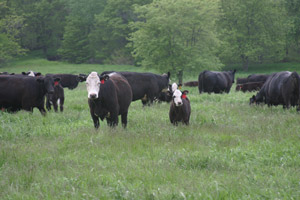Reducing methane production in a forage-based diet
April 2014
 It is well documented that diets high in grains (example: finishing diets used in beef feedyards) result in the most gain for pound of feed consumed and also result in lower methane emissions than most forage-based diets. However, throughout the production cycle of raising beef in the U.S., about 85% of the feed required to get cattle to market will be from forages.
It is well documented that diets high in grains (example: finishing diets used in beef feedyards) result in the most gain for pound of feed consumed and also result in lower methane emissions than most forage-based diets. However, throughout the production cycle of raising beef in the U.S., about 85% of the feed required to get cattle to market will be from forages.
The total feed required for market beef includes the feed needed for the cow (primarily forage) for the entire year. Additionally, most cattle are marketed for beef at 45-500 days of age, but, on average, the cattle will be consuming a high grain diet for only 160 of those days. As a result, determining how to improve the efficiency of forage utilization will benefit beef production in the U.S. by helping the producer and the environment.
Producers are generally aware that higher forage quality results in greater digestibility which translates into greater weight gain and less feed per pound of gain in the animal.
Research has also indicated that increased quality and digestibility in forages results in reduced methane production. Grazing systems which include rotational grazing will have a tendency to reduce forage maturity, which improves forage digestibility and therefore, reduces methane production.
Recent University of Nebraska–Lincoln research indicates that methane production is less for cattle consuming cool season grasses compared to warm season grasses. Again, this is likely a function of the fiber content of the forage which impacts digestibility. Additionally, cattle fed or grazing legume mixes have been shown to have reduced methane production compared to when they are fed or are grazing grass only forages.
Corn silages, when fed to cattle, have been shown to result in less methane produced than when fed grass silages. This is possibility due to the corn (starch) in corn silage or could be related to fiber content and digestibility.
Incorporating higher quality forages into diets fed to cattle, when economically feasible, helps to improve feed efficiency and reduce methane production, benefiting both the producer and the environment.
Karla H. Jenkins, Assistant Professor
Panhandle Research and Extension Center
University of Nebraska- Lincoln
References:
Hristov, A.N., J. Oh, J.L. Firkins, J. Dijksta, E. Kebreab, G. Waghorn, H.P.S. Makkar, A. T. Adesogan, W. Yang, C. Lee, P.J. Gerber, B. Henderson, and J.M Tricarico. 2013. Mitigation of methane and nitrous oxide emissions from animal operations: I. A review of enteric methane mitigation options. Published online before print September 17, 2013, doi: 10.2527/jas.2013-6583 J ANIM SCI November 2013 vol. 91 no. 11 5045-5069.
Pesta, A., A. Watson, S. Fernando, G. Erickson. 2014. Effects of forage quality, MDGS, and monensin on performance, methane concentration, and ruminal fermentation of growing cattle. NE Beef Report MP99:29-31.